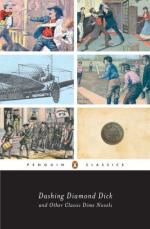|
This section contains 7,641 words (approx. 26 pages at 300 words per page) |

|
SOURCE: “‘Iron Dudes and White Savages in Camelot’: The Influence of Dime-Novel Sensationalism on Twain's A Connecticut Yankee in King Arthur's Court,” in American Literary Realism, 1870-1910, Vol. 27, No. 1, Fall, 1994, pp. 42-58.
In the essay below, Pfitzer argues that Twain transformed the formulaic components of dime novels into a masterpiece of literature.
In the summer of 1884, Mark Twain was enjoying a rare moment of self-satisfaction. Having just finished writing the Adventures of Huckleberry Finn after long delays, he was hard at work on a sequel which by contrast seemed to be writing itself—a western novel tentatively entitled Huck Finn and Tom Sawyer among the Indians.1 Fulfilling Huck's promise to “light out for the Territory” at the conclusion of Huck Finn, Twain sends his rambunctious hero out West to experience life among “the Injuns.”2 In preparation for this relocation of Huck from the soggy riverbanks of the Midwest...
|
This section contains 7,641 words (approx. 26 pages at 300 words per page) |

|


